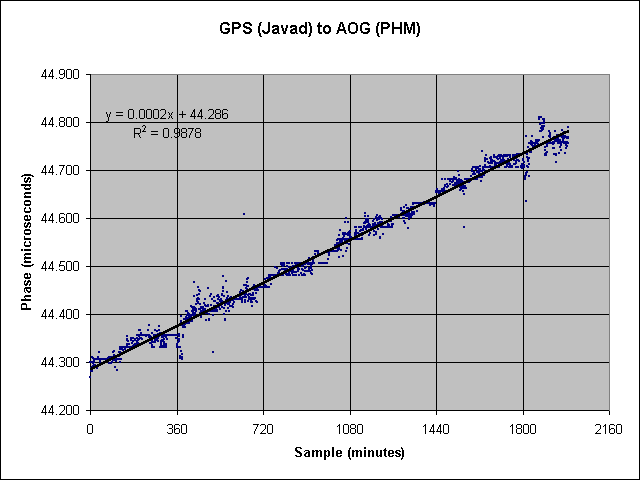
The CH1-76 to AOG to Javad arrangement was started on 2002-02-07:
----- Original Message ----- From: "Tom Van Baak" <tvb@leapsecond.com> To: "Doug (k4utc) Hogarth" <dougho@niceties.com> Sent: Thursday, February 07, 2002 11:00 Subject: PHM / AOG / Javad > Doug, > > Log file tvb10207a.jps will be truncated. Starting with > log file tvb10207e.jps the Javad ref will be the AOG > driven by the PHM. The PHM was running fast so the > AOG frequency steer is -1234E-14 (= -1.234E-11). > I didn't bother to reset the PHM itself and this AOG > offset is a little arbitrary but close enough for now. > > /tvb |
The AOG steering was set to "-000123400000E-19" which is -1.234E-11. I forget why I set it to this value except that the decimal positions 1, 2, 3, and 4 correspond to 1E-11, 2E-12, 3E-13, and 4E-14 on the AOG display so it's easier to read. Like I said, it was somewhat arbitrary.
Note the PHM has had episodes of instability since then - where the normal E-13 noise rises to E-11 or more. These periods last for minutes to days. I'm not sure what effect it has had on net frequency error. But the maser has appeared stable again the past few weeks.
Anyway, it is now 2002-03-04 and I'm getting sick of the large frequency offset so let's make a rough adjustment to the AOG.
The TI drift from a HP 58503B GPS 1 PPS reference to the AOG 1 PPS is approximately +40 ns per hour meaning the AOG is too slow by approximately 1E-11. The back-of-the-envelope calculation is as follows:
| Time (2002-03-04) | Time Interval (GPS to AOG) | Frequency error |
| 06:45 AM PST | +82 ns | |
| 07:45 AM PST | +126 ns | +44 ns / 1 h = 1.2E-11 |
| 10:45 AM PST | +250 ns | +124 ns / 3 h = 1.1E-11 |
| 11:45 AM PST | +277 ns | +27 ns / 1 h = 7.5E-12 |
| Time (2002-03-06) | Time Interval (GPS to AOG) | Frequency error |
| 07:00 AM PST | +2448 ns | +2366 ns / 48 h = 1.4E-11 |
| Time (2002-03-07) | Time Interval (GPS to AOG) | Frequency error |
| 00:01 AM PST | +3281 ns | +833 ns / 17 h = 1.4E-11 |
I changed the AOG from -1234E-11 to -2345E-12 at 0h PST 7-Mar, which is 8h 2002-03-07 MJD 52340. That should reduce the frequency error by an order of magnitude. Next time we'll get scientific about it.
N.B. The maser was acting up again pretty badly on 4-Mar and 5-Mar; often the short-term noise was 1E-11 instead of 4E-13 per division (on TSC 5110A frequency difference plot).
I've been running a SR620 with TI from the Javad 1 PPS to the PHM/AOG 1 PPS. The times have grown from 30 us to 40 us over the past month. This week I took 1 Hz samples with a 53132A and here are the results. Log file is log9055.txt.

TI goes from about 44.280 us to 44.730 over 1800 minutes. Either GPS is fast or PHM/AOG is slow to cause this slope. So the rate error is 450 ns in 1 ¼ days (1800 * 60 = 108,000 seconds) which is 4.12E-12.
The AOG is set to -000023450000x10-19 which is -2.345E-12. Since AOG is slow we need to increase it by 4.12E-12 for a new value of +1.775E-12 which is +000017750000x10-19.
| old frequency offset | -000023450000x10-19 |
| new frequency offset | +000017750000x10-19 |
This new value set-immediate at 24h PDT 2002-07-17 which is 07:00 UTC on 7/18, MJD 52473.
Immediately preceding raw 1 Hz data was log9075.txt and following raw data is log9080.txt.
I merged several TI logs and below is a 5-day plot showing the success of the AOG rate change a few days ago.
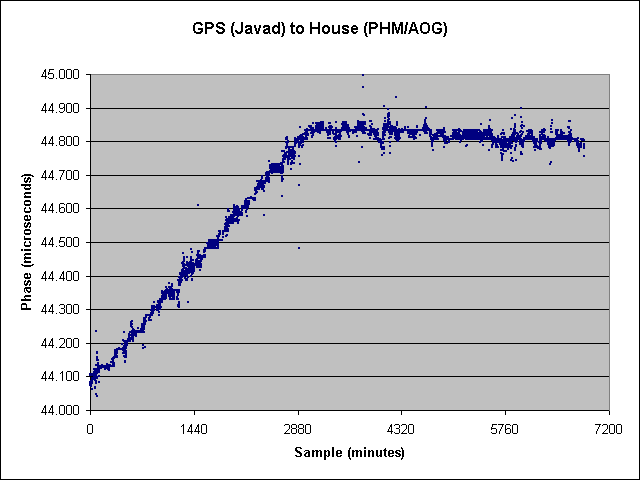
For the two days before the rate step we see an AOG phase error of +700 ns which is a frequency error of -4.0E-12:
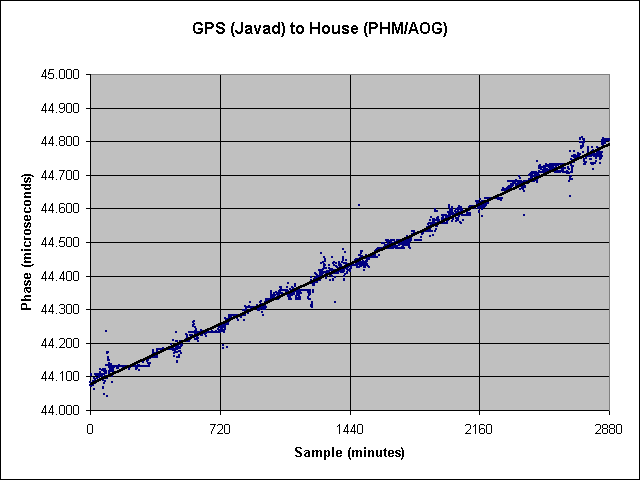
For the two days after the rate step we see an AOG phase error of -30 ns which is a frequency error of +1.6E-13:
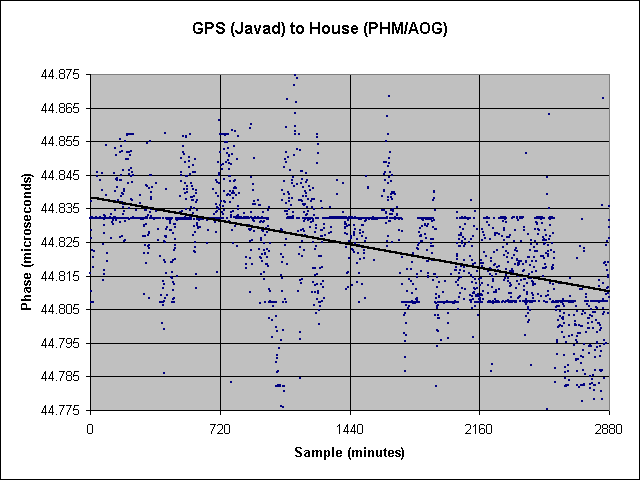
It's also evident in the above plot that the Javad 1 PPS has a strong 25 ns quantization. Below is a 5 ns/div close-up. My guess is the internal clock is 40 MHz - which causes a strong preference for 1 PPS phase positions separated by 25 ns. Not sure if this is a Javad bug or a feature - but it makes it difficult to reliably measure rate offsets down in the 1E-13 range.
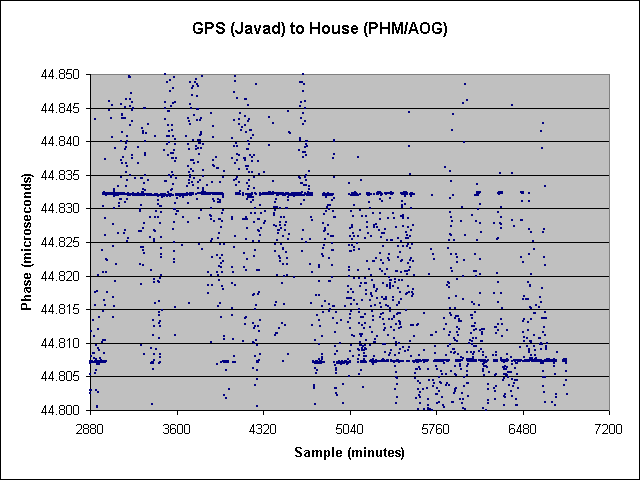
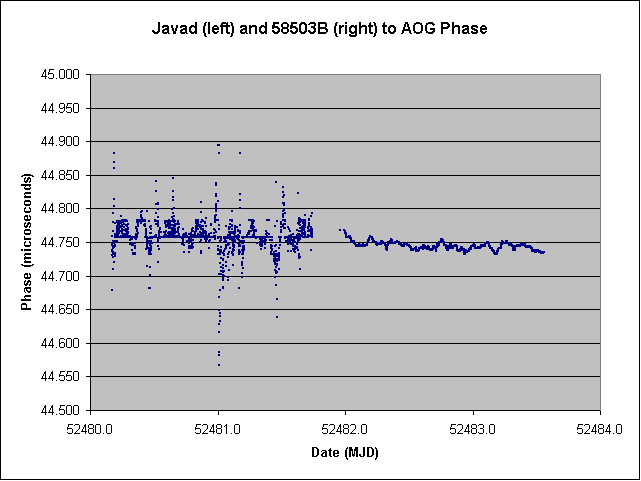
/tvb